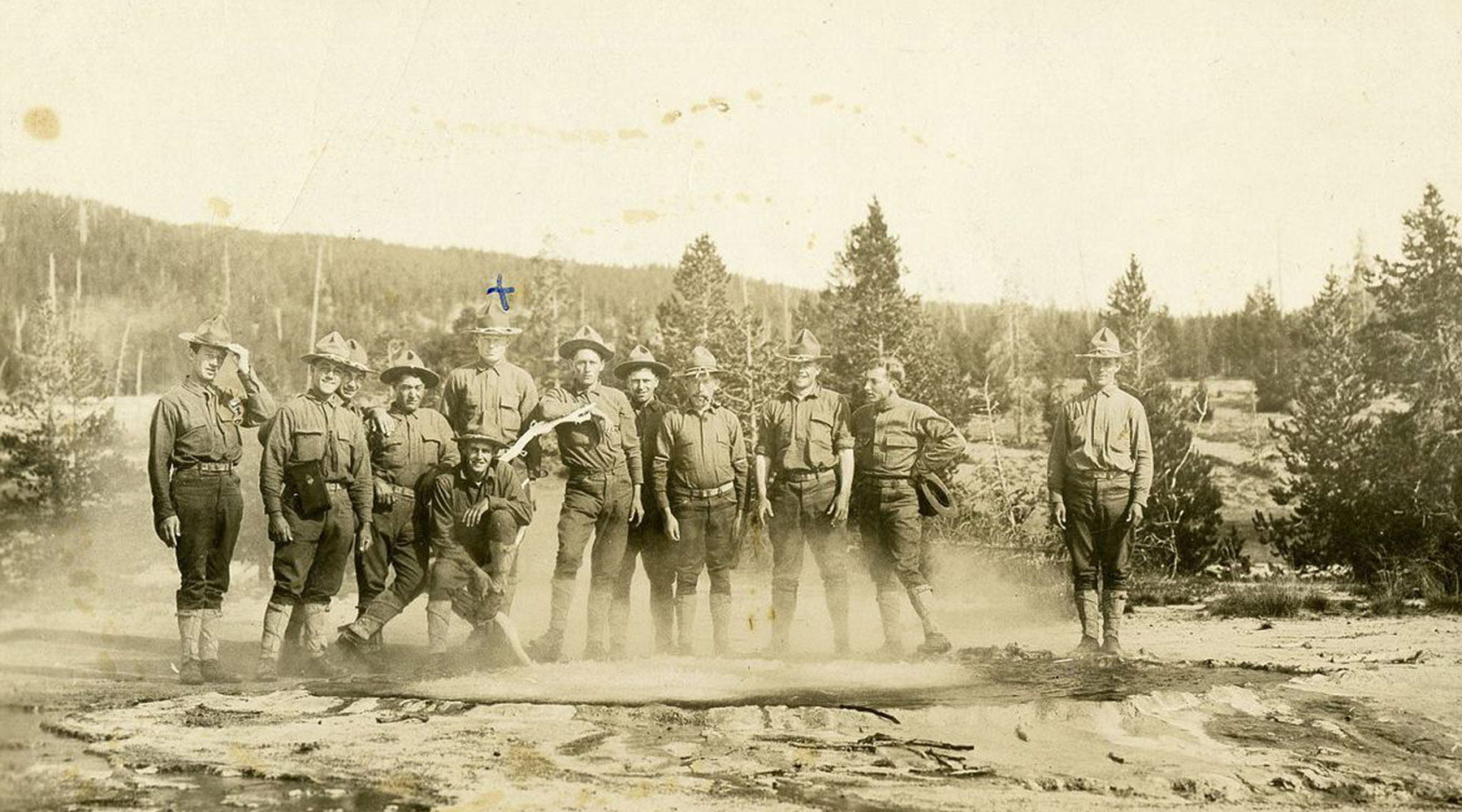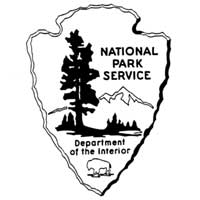Your Cart is Empty
The Ultimate Guide to Iconic National Parks Embroidered Patches

When Yellowstone National Park was founded in 1872 as a “public park or pleasuring-ground for the benefit and enjoyment of the people,” it was a highly controversial decision. There was no precedent for setting aside land simply for its own protection, and many people were furious that they could no longer hunt and log within the resource-rich valleys of Yellowstone. Many thought the foolish idea would soon pass over. They couldn't be more wrong.

Here is a collection of vintage National Park patches I recently purchased on eBay. Every patch in this article has photo credits at the end where you can find the source of the image and how to find these patches in various stores.

Today, more than 150 years later, the American national park system was grown to become a worldwide park movement. Now there are over 1,200 national parks in 100 nations worldwide, with the United States boasting over 400 nationally-preserved areas.
These national parks have become a cherished part of the American landscape, serving both as a refugee for plants and animals and as a respite for people trying to reconnect with the natural world.
Importance of National Park Patches
Patches and badges have been a significant part of the National Park's history since the beginning. The earliest badges were given in 1894 to “Yellowstone Park Scouts”, or young men that were hired to protect the park from illegal poaching. The badge was silver, just two inches long and read 'Yellowstone Park Scout' across the front.

Eventually, these badges were replaced by the more official government-issued National Park Service badge that all park rangers wore as part of their uniforms. Early badges were made from metal like this 1905 example (image). Fabric patches were soon created that could be worn on outer clothing where a metal badge would be inappropriate.

In 1949, a contest was held to create a new badge for the park service, who wanted a way to separate themselves from the forest service. Though the winning design was never used, an arrowhead design that incorporated a sequoia and bison was authorized in 1951 and has been the standard badge of the park service ever since.


2016 marks the national park service's 100 year anniversary. As park rangers reflect on their challenges and victories over the past century, it's time to turn towards the new challenges that the next hundred years will bring.
National Park Patches
Today, you don't have to be a park ranger to enjoy the fun of National Park patches. Every park gift shop will have unique patches for sale that you can add to your collection. Below is a sampling of some of the patches (both vintage and contemporary) from America's most popular national parks.
Western US

Crater Lake, Oregon: Est. 1902
Mount Mazama was an ancient volcano that blew it's top off seven thousand years ago, and now all that remains of the powerful explosion is an immense crater that slowly filled with melting snow to become the deepest lake in the United States. Known for the deep blue hue of its water and its exceptional clarity, Crater Lake's serenity today hides its explosive past. Image.

Death Valley, California: Est. 1994
Death Valley wins the triple award of being the hottest, driest and lowest place in the United States. The daily temperature has been measured at a record-breaking 134 degrees Fahrenheit, and many an unprepared hiker has lost her life in the entrancing landscape. Though the landscape may look desolate, over 1000 species of plants call this valley home. image.

Glacier, Montana: Est. 1910
Known to Native Americans as the “Backbone of the World”, Glacier is a site to see. The stunning peaks of the Rocky Mountains are encased in 26 glaciers at Glacier National Park. As a valued fossil spot, the mountains in the park contain the world's best preserved sedimentary fossils.

Grand Teton, Wyoming: Est. 1929
As both the tallest and youngest mountains in the Rocky Mountains, the Tetons are a spectacular site to behold. The mountains appear to be an optical illusion when they rise up seemingly from nowhere from the surrounding flat valley.

Great Basin, Nevada: Est. 1986
Did you know that trees can live to be over 5,000 years old? In Great Basin National Park, they do. Home to some of the world's oldest bristle cone pines, the Great Basin is also an incredible place to stargaze.

Kings Canyon, California: Est. 1940
If you do nothing else on your visit to King's Canyon, you will need to say hello to General Grant, the world's second largest tree who towers above the landscape at 267 feet. He is immortalized on this vintage park patch.

Mesa Verde, Colorado: Est. 1906
You can get a glimpse of ancient Puebloan home life from Mesa Verde, the location of over 4,000 archaeological sites within the rocky cliffs. Mesa Verde was inhabited over 7,000 years ago, and visitors today can still see the 150 room cliff palace among the ruins.

Mount Rainier, Washington: Est. 1899
As an active volcano, Mount Rainier is the most well known mountain peak in the cascade range. A popular climbing spot, one of the sides of the mountain is the snowiest place in the world where snowfall is measured regularly.

Olympic, Washington: Est. 1938
Surprisingly enough to most visitors, Olympic National Park is home to a rainforest and is the wettest area in the United States. Also boasting the longest undeveloped coastline in the contiguous US, the park is filled with plants and animals that thrive no where else.

Rocky Mountain, Colorado: Est. 1915
Full of rustic beauty, Rocky Mountain National Park has full panoramic views of majestic mountain and secluded mountain lakes. To get the full effect, you can travel through the park on Trail Ridge Road, the highest paved road in the United States.

Sequoia, California: Est. 1890
Home of America's Giant Forest, Sequoia contains some of the world's most massive trees, with General Sherman being the largest in the park. If you get tired of looking up, you can wander through the park's 240 caves instead.

Yellowstone, Wyoming, Montana, Idaho: Est. 1872
Sitting atop a long dormant volcano that may reactivate at any time, Yellowstone is filled with geothermal activity like scalding hot springs, boiling mud pots and the famous Old Faithful geyser. Though the park is often busy, few people journey off the main paths and parts of the back country of Yellowstone are farther from roads than any other part of the continental US.

Yosemite, California: Est. 1890
Nature writer John Muir's baby, Yosemite features breathtaking granite cliffs and impressive waterfalls, all within an a diverse ecosystem filled with old growth forests and lush valleys. Yosemite has long been a favorite park for American tourists, and this stitched cloth patch probably dates from the 1980s.
South West

Arches, Utah: Est 1971
Within the desert climate of Utah, Arches National Park showcases over 2,000 natural sandstone arches that were formed from millions of years of erosion by the strong desert winds. In 2010, astronauts on the space shuttle Endeavor approved that the appeal of US National Parks is truly out of this world when they took this official Arches park patch into space with them.

Bryce Canyon, Utah: Est. 1928
As a location of several giant natural amphitheaters in the shape of horseshoes, Bryce Canyon is known for having unique geography. Millions of years of rain water have pelted out the stone shapes you can see today, making any hike through Bryce a bizarrely Martian experience. 
Grand Canyon, Arizona: Est. 1919
Carved away over millions of years by the Colorado River, the Grand Canyon had been a home for Native Americans for twelve thousand years before it became a national park. Now, over five million visitors come to the rim every year, though few venture farther than taking a quick picture.

Zion, Utah: Est. 1919
Zion National Park leaves an impression on every visitor with its colorful sandstone canyons, rock towers and exposed natural arches. Native Americans lived in Zion as far back as 6,000 B.C and the region still contains hints of their presence.
Eastern US
Acadia, Maine: Est 1919
As the oldest National Park east of the Mississippi, Acadia boasts miles of coastline along the ocean and the tallest mountain along the Atlantic. Within Acadia, freshwater lakes meet granite ocean coastline, a feature that is memorialized in this classic park patch.

Mammoth Cave, Kentucky: Est. 1941
Don't get lost in Mammoth Caves because you'll find yourself with more than 400 miles of passageways to wander in. As the world's largest cave system, Mammoth caves provides an eery tour for any brave adventurer.

Great Smoky Mountains, Tennessee: Est. 1934
As the country's most visited National Park, the Great Smokies are not a place you want to miss. Filled with cultural history of Southern Appalachia, the Smokies are a filled with historic structures as well as gorgeous vistas and hiking trails.

Shenandoah, Virginia: Est. 1926
The world-famous Appalachian trail runs straight through this park, which is home to the gorgeous Blue Ridge Mountains. Even if you don't choose to hike the AT, there are over 500 miles of hiking trails within the park for you to explore.
Midwest
Badlands, South Dakota: est. 1978
Formed from thousands of acres of sharply eroded buttes, pinnacles and spires, the Badlands of South Dakota make up the largest undisturbed prairie system in the United States. The eery landscape once looked quite different, as evidenced by the marine fossils that have been found that reveal the area was once part of an inland sea. Though the ocean has long since dried up, lucky visitors can still catch site of buffalo foraging on the plains.

Isle Royale, Michigan: Est. 1940
As one of the few national parks where you can hike to shipwrecks, this park contains over 400 small islands that are home to just twenty species of mammals. The dynamics between Isle Royale wolves and moose are a favorite of scientists to study.
Southern US
Big Bend, Texas: Est. 1944
Named after the, well, 'big bend' in the Rio Grande as it snakes along the US-Mexico border, Big Bend National Park boasts fossils, isolation, and a whole lot of rocks. A favorite place for back country campers, Big Bend is considered one of the best places to stargaze on the planet.

Everglades, Florida: Est. 1934
As the largest tropical wilderness in the United States, the Everglades are filled with mangrove forests, marine estuaries, and yes, crocodiles! This patch is a vintage version from the 1980s.
Non Continental US
Hawaii Volcanoes: Est. 1916
Located on the Big Island of Hawaii, this park is home to two of the most active volcanoes on earth, Mauna Loa and Kilauea. The red flowers on this patch represent Pele, the Hawaiian goddess of volcanoes.

Denali, Alaska: Est. 1917
Existing prominently on Mount Denali (the highest point in North America), Denali National Park contains over six million acres of pristine glacial forests. In fact, only one road goes through the park. Be warned, grizzly bears often out number people in this out of the way park!
If you're interested in learning more about the national park system, CNN has a great article that walks you in-depth through the last 100 years of national Park System. NPS also has a fantastic archive of historical images that can be found here.
Photo Credits
Introduction Section
https://www.nps.gov/parkhistory/online_books/workman1/
https://www.nps.gov/parkhistory/online_books/workman1b/volf.htm
https://www.nps.gov/parkhistory/online_books/workman2/vol2c.htm
http://www.nwo.usace.army.mil/Media/News-Stories/Article/945409/whats-with-the-hat/
https://www.nps.gov/parkhistory/online_books/workman1b/volc.htm
http://www.pbs.org/nationalparks/history/ep3/2/
http://www.history.com/news/10-things-you-may-not-know-about-yosemite-national-park
Crater Lake
Death Valley
Glacier
Grand Teton
Great Basin
Kings Canyon
Mesa Verde
Mt. Rainier
http://expeditioncollectibles.com/shop/mt-rainier-patch/https://www.etsy.com/listing/172365552/mt-rainier-patch
Olympic
Rocky Mountain
Sequoia
Yellowstone
Yosemite
Arches
Bryce Canyon
Grand Canyon
Zion
Acadia
Mammoth Cave
http://merrilyrollingalong.com/gallery/great-smoky-mountains-np/
http://www.eparks.com/store/product/115360/Great-Smoky-Mountains-National-Park-Patch/
Shenandoah
http://www.eparks.com/store/product/115360/Great-Smoky-Mountains-National-Park-Patch/
Shenandoah
http://www.terapeak.com/worth/vtg-skyline-shenandoah-valley-national-park-patch-state-of-virginia-66wb/152139013027/
http://www.heidimicheledesign.com/traveler-patchespins/shenandoah-national-park-traveler-patch
Badlands
http://www.heidimicheledesign.com/traveler-patchespins/shenandoah-national-park-traveler-patch
Badlands
https://www.pinterest.com/pin/427138345882051880/
https://www.pinterest.com/pin/89016530107410289/
https://www.pinterest.com/pin/456341374712620508/
https://www.pinterest.com/pin/89016530107410289/
https://www.pinterest.com/pin/456341374712620508/
Isle Royale
https://www.pinterest.com/pin/571112796465772237/
http://www.eparks.com/store/product/115371/Big-Bend-National-Park-Patch/
Everglades
http://www.eparks.com/store/product/115371/Big-Bend-National-Park-Patch/
Everglades
http://www.hawaiipacificparks.org/store/keepsakes/patches/patch-havo-park-logo.html
https://www.etsy.com/listing/202522066/hawaii-hawaii-volcanoes-national-park
http://www.hawaiipacificparks.org/store/keepsakes/patches/patch-hale.html
https://www.etsy.com/listing/202522066/hawaii-hawaii-volcanoes-national-park
http://www.hawaiipacificparks.org/store/keepsakes/patches/patch-hale.html
Denali
https://www.whittakermountaineering.com/brands/mt.-mckinley-patch
http://www.terapeak.com/worth/denali-national-park-state-of-alaska-souvenir-patch-moose-i-think-61c7/151966430740/
http://www.terapeak.com/worth/denali-national-park-state-of-alaska-souvenir-patch-moose-i-think-61c7/151966430740/
Also in Asilda Blog

Why I started Vlogging - My 3 Reasons
The first month of vlogging is done and now I get asked more and more about why I started all this, and especially right now. So here are my three reasons.
Read More
Cecilia Humboldt Camera Backpack Review
Join me in reviewing this Cecilia Humboldt 14L in Black Leather Camera Backpack I got to test out. The leather is buttery smooth and the bag is very enjoyable to use.
Read More
Neon Signs: A Symbol of America
When you think Americana, neon signs are always a big part of the visual. In this article, you'll find out about the history of neon signs...
Read More







